I was puzzled, this year, by the appearance of yellow foliage on some of my young pines. Yellow foliage is common on weak trees and often results from bad soil, under-feeding or various kinds of infestation. All of my pines are in the same soil, get the same sunlight and fertilizer and show no signs of infestation. Yet some trees are decidedly yellow.
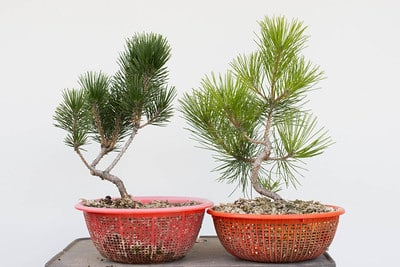
Healthy dark green foliage and unhealthy yellow foliage
The one place I hadn’t checked was the soil. I scraped away the top inch or so of soil. Hardly any roots had grown since the tree was repotted in late winter.
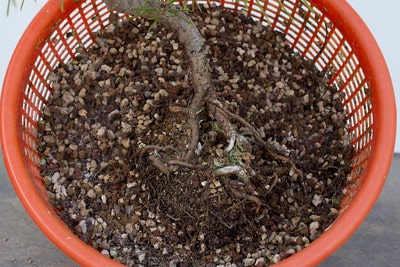
No sign of new roots
Upon a closer look, I spotted a suspicious white patch. I took a picture, went into the house and zoomed in as far as I could on the monitor. Aha – root aphids!
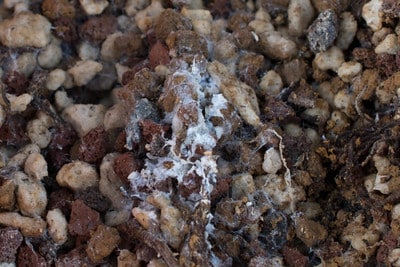
The culprit – root aphids
I’d suspected root aphids as I’d seen a few while repotting, but they haven’t caused problems like this in past years – at least, not that I’d been aware of. I checked some of the younger pines.
The one year-old pines below looked OK at first glance.
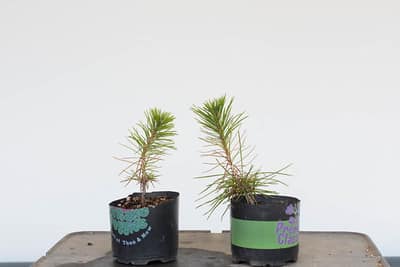
One year-old pines
Until I compared them with a healthy seedling that’s the same age. Something was wrong.
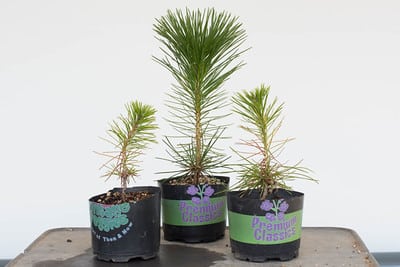
Weak seedlings flank healthy seedling
I checked these trees by bare-rooting. The soil looked clean.
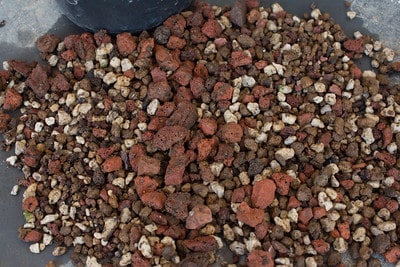
Clean soil
As with the older tree, there was little sign of root growth. Healthy trees typically fill the container with roots by midsummer. I magnified the photo below and spotted more suspicious white patches.
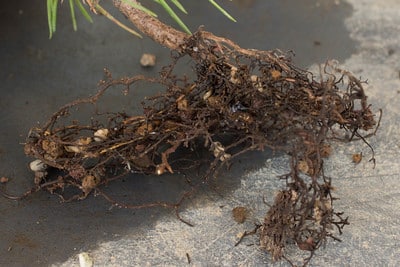
No new roots; small white patches – looks like root aphids
Root aphids are tricky to manage because they’re hard to see and hard to get to. I thought about what to do about it for some time.
In the following weeks I reflected on the loss of several young pines during the winter. Various professional opinions suggested different causes of death, but lab analysis found no evidence of disease or fungus. The symptoms were similar – yellow foliage and little to no root growth. I started to think root aphids may have been to blame.
During my recent visit to Bonsai Mirai, Ryan Neil and I talked about root aphids and the different approaches to managing them. The standard treatment is to apply systemic insecticide ahead of infestation. Active infestations may require more rapid response, and severe infestations can’t always be avoided with systemics. The next best option is to use a soil drench.
With a soil drench, I can use contact insecticides to get the aphids in the soil. The one thing to watch out for is phytotoxicity.
I decided to do some tests. I prepared a solution of pesticidal soap and soaked a few trees for 2 minutes each.
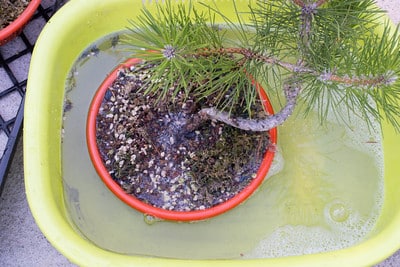
Soaking a black pine
To make sure the solution came in contact with all of the roots, I used a repotting tool to perforate the center of the rootball where roots and degraded soil made it difficult for moisture to penetrate.
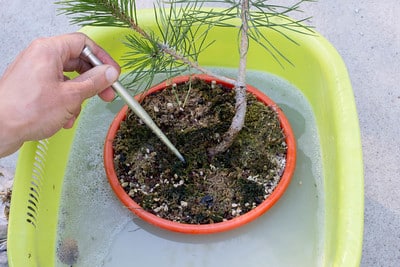
Perforating the rootball
After soaking the trees I monitored them closely. I also stopped feeding them. Root aphids love the boost trees get from nitrogen so I figured taking away the extra food might further stress the insects.
As pines can be slow to show signs of stress, it’s hard to say how long it might take to see signs of phytotoxicity. That said, it’s hard to measure the continued adverse effects of infestation. After two weeks passed with no visible signs of stress, I expanded the experiment.
Over the next week I dunked 116 two and three year-old red and black pines in seven different treatments. (The application rates and dates are provided to help me keep track of what I’ve done.)
- Pesticidal soap (47%) – 5 oz/gal
- Applied to 4 trees 7/1 and 16 trees 7/12
- Neem oil (70%) – 1 oz/gal
- Applied to 24 trees 7/18
- Imidacloprid (1.47%) – 6 oz/gal
- Applied to 20 trees 7/14
- Bayer All in One (Tebuconazole .80%, Imidacloprid .15%, fertilizer 9-14-9) – 1 oz/gal
- Applied to 16 trees 7/14
- Bifenthrin (25.1%) – .75 ml/gal
- Applied to 16 trees 7/21
- Malathion (50%) – 1 tsp/gal
- Applied to 4 trees 7/18
- Beneficial Nematodes – 7 million dissolved in 1-2 gallons of water
- Applied to 16 trees 7/14 by watering, not dunking
It’s too soon to tell what will come of the experiment, though a few of the weaker trees have already greened up a bit. Others are as yellow as ever – for these it may be too late for treatment. I started fertilizing two weeks after treatment and will slowly build up to higher fertilizer levels.
As I don’t know which trees were affected or how bad the infestations were, I don’t expect to make any grand conclusions about which treatments are most effective for stopping root aphids. What I do hope to learn is whether or not the treatments are toxic to the trees and whether or not I see evidence of infestation when I repot next year. If the trees are healthy and I don’t see a lot of aphids, I’ll be ready to treat more mature trees as the need arises.
UPDATE (2019): There is no follow-up article to this post. I didn’t repot these trees the following winter so I had no way of measuring the results. When I repotted one year later, almost all of the aphids were gone so it’s hard to say if the treatments worked or if the aphids moved on without prompting. If I get the opportunity to make such a test in the future, I’ll do everything I can to follow-up with the results.
Subscribe to Bonsai Tonight
New Posts Delivered Every Tuesday and Friday
Zack Clayton says
These experimental blogs with chemical effect on the trees (rooting and pesticide) are very educational. I like what you are doing here. I look forward to hearing the long term results.
Mac McAtee says
Another good piece of information Jonas. Thank you. Looking forward to see how this comes out. Meanwhile if one had an infestation which one of your remedy’s would you recommend to try for an emergency situation?
Jonas Dupuich says
Hi Mac – I started with pesticidal soap and imidacloprid. Imidacloprid is made for uptake via roots and the soap is less toxic for things other than insects – the wikipedia entry on it has some good info on soaps: https://en.wikipedia.org/wiki/Insecticidal_soap
I’d always consider at least brief experiments (starting with less dear trees) when working with different varieties because each treatment may react with different varieties in different ways.
Eric Schrader says
Jonas – I think I mentioned to you that I had the same problem this year. Nearly every JBP in my yard had root aphids. The symptoms were the same as well…yellowy foliage and weak growth. I treated everything with granular imidacloprid (lawn grub control stuff) and the results since have been much better. Interestingly, I still have a couple pines that are quite yellow. I did read that poplar family trees are the intermediate host for part of the life cycle of conifer root aphids. So if you (or your neighbors) have any aspen, cottonwood, poplar etc you might try a dormant spray on them for the winter to be sure they’re not allowing regular re-population of the aphids.
Kevin says
Seeing this came at a great time for me. I’ve had the issue with nursery stock pines and wondered. Love their elegance but tended to steer clear. I have a really substantial one now and am very happy to see this information. I think all of the focus with pines seems to be on needles and candles, balancing energy, etc. This is needed.
Please be encouraged by the responses and keep sharing what you are discovering!!!
crataegus says
Really important experiment, Jonas, thanks for sharing the start of it, please let us know your results!
Peter says
Is this not myccohiza which is beneficial for conifers?
Jonas Dupuich says
Hi Peter – root aphids create a white substance that looks similar to mycorrhiza. Plus, there is some mycorrhiza growing in these pines. I can often tell the two apart but sometimes it’s tricky, especially when root aphids live amongst mycorrhiza.
Thomdec says
Very valuable information. Let us know what treatment is best and the time required to see the results. My JRP was very yellow last year, but after a few applications of chelated iron the yellowing diminished in time.
brendenstudio says
Great post Jonas!
Heidi Wellnitz says
Hi Jonas, Even though I leave in Sone 10 (Florida tropical in the summer) I like to follow your blog. We recently had Rodney Clemens here on his Florida tour. On person had root aphids on a Bald Cypress. He recommended Fire Ant Killer. He is using that in his pines. Why I am writing this? I have a much beloved Florida Slash Pine, which has been yellow now and barely surviving for 2 years. I treated it with the best fertilizer (chemical or Organic etc), nematode treat,net – no difference, except now I lost the bottom branch and the top is dead. When I read your article on the yellowing BP I think I know what is wrong with my tree. I am hoping the info did not come too late.
Thank you for the work you put into your blogs. Heidi Wellnitz
Marty says
Ortho Fire Ant Killer is listed as containing 50% Acephate which Wikipedia list as being effective against aphids that recommendation makes sense.